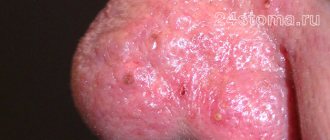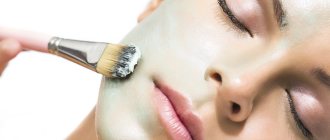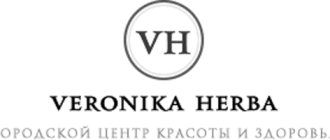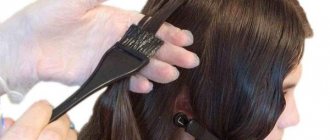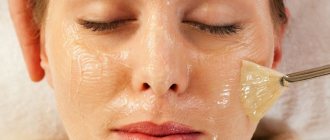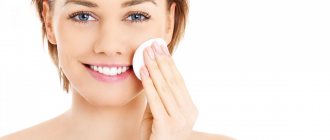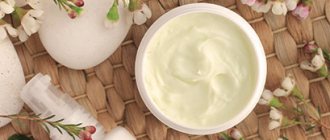Main principles of skin care after chemical peeling
Regardless of the type of peeling used and the degree of its penetration into the layers of the skin, there are a number of requirements that must be strictly observed during the recovery period.
Under no circumstances should you touch your face on the first day . This means that any procedures related to washing, applying moisturizers, etc. are prohibited. The only exceptions are special instructions from a cosmetologist regarding the specifics of the procedure itself. For example, with retinoic or yellow peeling, you will need to remove the product from your face yourself in strict accordance with the recommendations received. It is undesirable to touch your face in the following days, since injured skin is very susceptible to the action of bacteria that can cause serious inflammatory processes.
You can only wash your face the next day with clean boiled water . The cleansers used should be mild and should be applied to the face carefully, using your fingertips. During the recovery period - and after chemical peeling, it can take up to 2 months - you should avoid using scrubs, which will further injure the epidermis and can lead to scarring.
To alleviate the condition, as well as to prevent the skin from cracking and cracking whenever severe tightness appears, it is recommended to use moisturizing gels or foams that are easy to apply and absorb well. It is better not to use creams at first - their time will come when the skin begins to peel off. In this case, it is advisable to select products with moisturizing, antioxidant, anti-inflammatory, regenerating properties - the composition will include selenium, omega acids, Shea butter, hyaluronic acid, retinol, etc.
An excellent product for moisturizing the skin and accelerating the regeneration process is Panthenol spray - it is advisable to purchase it in advance and always have it on hand. Panthenol is generously applied to the facial skin several times a day (3-4 after superficial peeling and 7-8 after medium peeling) until the skin is completely restored. Excess Panthenol should be easily removed with a clean cloth after a quarter of an hour. Despite all the advantages of Panthenol, it must be used in accordance with the recommendations: after superficial chemical peeling - a day later, after medium peeling - no earlier than 3-4 days (by this time a strongly constricting film will appear on the face, with a color ranging from normal to brown).
No one denies the positive effects of various soothing masks made from natural ingredients on irritated skin, but it is better not to resort to them on your own during the post-peeling period. Here you need a preliminary consultation with a cosmetologist, since even the most familiar product can become a strong allergen and cause irritation.
What is peeling
Exfoliation (peeling) is a procedure during which dead skin is removed from the facial skin and the surface itself is cleaned. After it, the following consequences may appear:
- peeling - from 2 to 7 days;
- redness (especially after chemical peeling) - up to 5 days;
- slight tingling or burning – up to 2 hours;
- swelling - occurs on thin skin and lasts up to 5 days.
The effect of the procedure is beneficial for the skin, as it starts regeneration processes, activates blood circulation and prevents the appearance of wrinkles. However, peeling is quite harsh, so after the procedure the skin needs to be helped to recover.
Note!
- If a film appears on the face after medial peeling, it is better to eat pureed, soft food in order to strain the facial muscles less.
- It is forbidden to remove flaky layers of skin or formed crusts - this is one of the reasons for the appearance of scars after peeling. The skin should cleanse itself of dead cells, even if it takes a long time - a week or more (it all depends on the type of peeling and the degree of its effect on the epidermis). Washing and applying moisturizer is all you can do to help your skin during this period.
- During the period of skin restoration, you cannot use decorative cosmetics; in extreme cases, only light tinting of the eyes and lips is allowed. You can switch to your usual facial care products when the skin gets rid of the primary effects of peeling: redness, swelling, peeling.
- It is advisable to plan the medial peeling so that 3-4 days after it can be done at home and not go outside in order to avoid any environmental exposure.
- In the first 3 months after chemical peeling, it is strictly forbidden to visit a bathhouse, solarium, sauna, or go outside without a cream that reliably protects against sun rays (with an SPF effect of 30 or more). The same applies to trips to hot countries. The consequences of violating these requirements can be quite disastrous - scars or age spots will appear on skin that has not completely healed, and serious inflammatory processes will begin in the layers of the dermis, which can be very difficult, and sometimes impossible, to get rid of. That is why all peelings are recommended to be carried out during periods of low sun activity - in autumn and winter.
Ingestion of vitamins has a positive effect on the regeneration process and the elimination of possible inflammation. By the way, vitamins A and C will enhance the effect of whitening products, if they are prescribed by a specialist.
In case of unusual situations, for example, with a strong and persistent burning sensation, persistent redness, signs of allergies - this can be caused by both the peeling itself and the products used during the recovery period for skin care - you should immediately contact your doctor and get recommendations for further actions. Sometimes it may be necessary to prescribe a whole range of drugs and special procedures that will help avoid possible complications.
Thus, the result of chemical peeling largely depends not only on the skill of the cosmetologist, but also on your efforts. A little patience - and as a reward you will receive a refreshed and rejuvenated face.
Find out the cost of the Chemical Peeling procedure
Care after superficial peeling
At this stage, only the top layer of skin is affected. All unpleasant sensations disappear after 10 days. Formulations with glycolic, malic, tartaric, citric, lactic or phytic acids are used here.
Basics of care after superficial peeling: refrain from contact with water and direct sunlight for 24 hours, avoid touching your face, reduce time spent outside, drink plenty of fluids. You can also use light mousses and foams, and decorative cosmetics can be introduced as early as day 4. For better recovery, it is recommended to use the GIGI Vitamin E mask.
What is considered normal after peeling?
- Pimples after peeling are not uncommon and are no exception, especially if exfoliation was carried out just to get rid of them. The first way to eliminate it is acne. What to do - consult a cosmetologist - if the rash is severe, antibiotics and vitamins may be prescribed;
- Peeling after peeling is more than normal - it is with peeling skin that tissue renewal occurs. Peeling should never be peeled off or even gently removed, this can lead to complications. All crusts will fall off on their own. By the way, if your face does not peel, there is nothing wrong with that either: firstly, after some peelings there is no peeling, and secondly, the characteristics of the skin could influence it.
- Redness as a consequence of the burn gradually disappears during the healing process.
- Swelling of the face - especially after a medium peel lasting up to 3-5 days, in the case of a deep peel a little longer.
What is not considered the norm and requires consultation with a cosmetologist:
- inflammatory processes;
- cracks in the skin (as a result of poor hydration);
- pigmentation (may appear if there was no sun protection or the patient has a high predisposition);
- erythema;
- allergy;
- exacerbation of herpes;
- hypertrophic and keloid type scars.
Answers to important questions
The care and consequences are more or less clear, but here’s how things are going with the return to normal life.
- Is it possible to go to the bathhouse or sauna , to the pool and take a bath after peeling?
No. Water procedures in the pool are fraught with infection, and chlorinated water is dangerous due to irritation, the possibility of getting burned and drying out the skin.
Taking a bath, sauna and bath procedures are dangerous due to high temperatures, and this in turn causes sweating - that is, skin irritation, plus in a warm environment, bacteria actively multiply. You can return to your favorite water treatments after the skin has completely healed.
- Can I exercise after peeling?
Any workout leads to sweating, which, as in the case of bath procedures, leads to burning and irritation of the skin.
- When can you sunbathe/go to a solarium?
Sunbathing, both natural and artificial, is highly likely to cause hyperpigmentation, so you should abstain from tanning during the peeling course and for a month.
It is this factor that makes it preferable to carry out peelings during periods with minimal solar activity.
- Can I drink alcohol after peeling ?
Definitely no - at least a week or two, if peelings are carried out in a course - abstain for the entire period!
Why and what is fraught with:
- increased burns when interacting with chemical residues in the skin;
- intense erythema;
- increased swelling of the face and eyes;
- ineffectiveness of some types of peelings, the appearance of unwanted reactions of the body.
- Is it possible to make face masks?
Natural masks are completely prohibited, as they can cause inflammation on burned skin, injure particles and cause allergic reactions.
It is better to pay attention to professional masks designed for post-peeling care - mainly aimed at deep moisturizing, soothing and restoring the skin.
- When can you put on makeup or use foundation after a peeling procedure?
After superficial peeling, as a rule, it is allowed to apply cosmetics (tone, highlighter, powder, etc.) every other day. After medium and deep peeling, you should abstain for 7-14 days. It is worth noting that mascara and lipstick are not included in the prohibited list.
- Is it possible to cleanse your face after peeling?
In some cases, this is possible; after some light types of exfoliation, it is also possible to combine procedures. Only a cosmetologist can answer with accuracy.
- Is it possible to do peeling after biorevitalization and mesotherapy?
As a rule, there is no prohibition on carrying out; procedures often take place in parallel or at intervals. Only a cosmetologist can give an exact answer in accordance with the desired result and skin condition.
- Is it possible to peel after Botox/Dysport and filler?
Only a cosmetologist can give an answer, taking into account the time elapsed after the procedure and what type of peeling should be carried out. The fact is that after Botox or filler injection, the blood vessels in the treated area are compressed, this condition slows down the process of skin regeneration.
What to do if side effects occur?
Following your esthetician's recommendations will help prevent side effects from exfoliation. But what to do if they do appear? It is necessary to immediately contact a specialist to minimize the impact of complications on the skin.
Peeling of the epidermis is considered a normal reaction. It appears on the 2nd day after exfoliation and disappears after a week. To soften and speed up the process, you can use a moisturizer with hyaluronic acid as prescribed by a cosmetologist. On the 3rd day, it is recommended to include shea and grape seed butter in your facial care. They eliminate tightness and prevent scar formation. Before using cosmetics after peeling, consult a cosmetologist to see if this can be done in your situation.
Hyperemia or redness of the epidermis is characteristic of medium and deep exfoliation. It can remain on the face for up to 2 weeks. Therefore, to the question “How many days after peeling can you go to the sauna?” you can answer: until the redness goes away. For the same reason, fitness, stress, spicy food, and alcohol are prohibited. Omega-3 acid supplements will help the body cope with this problem.
Facial swelling after exfoliation may occur in women with thin skin. Products with antioxidants will help get rid of this side effect.
Pimples should not normally appear on the face after exfoliation. Their presence indicates incorrect post-peeling care. With this problem you need to contact a cosmetologist. He will prescribe antibiotics, sebostatic, anti-inflammatory or zinc-containing drugs on an individual basis.
An allergy test, which must be done before exfoliation, will protect you from allergies. During the rehabilitation period, you need to care for your skin with hypoallergenic cosmetics. If dermatitis does occur, the doctor prescribes antihistamines.
Attention! It is forbidden to peel off the resulting crusts; this can lead to infection, the formation of a scar or scar. Aseptic care and wound healing ointments based on panthenol or retinol are needed.
Hyperpigmentation can occur if exfoliation is done in the summer without prepping with kojic and retinoic acids. If spots appear, then discard products with extracts of St. John's wort, lemon, cinnamon, clover, lavender, and bergamot.
Is it possible to go to the bathhouse and play sports after peeling?
If you have exfoliated in a beauty salon, remember an important rule: a bath after peeling is taboo. For the next 48-72 hours after exfoliation of any kind, the skin should not be exposed to elevated temperatures and steam. Not only the traditional Russian steam room is prohibited, but also the Finnish sauna, Turkish hammam, phyto-barrel and other analogues.
Many women are interested in the question “Is it possible to go to the sauna after peeling and why?” In a sauna, as in a bathhouse, body temperature rises and sweating intensifies. Particles of the active substance that was used in chemical exfoliation begin to come out of the pores along with the liquid. At the same time, the effect of the procedure is noticeably reduced. In addition to increased sweating, during a stay in a sauna or bathhouse, a person’s blood vessels dilate and the skin turns red. This process prolongs the hyperemia of the skin for a longer period of time. Therefore, when a patient asks a cosmetologist, “Is it possible to go to the steam room or bathhouse after peeling?”, the specialists answer with a firm “no.”
A specialist in outdoor activities will give approximately the same recommendations. Can I exercise after peeling? You will hear an unequivocal “no!” from experts. Active sports also provoke sweating and redness of the surface layer of the skin. This interferes with the normal process of restoration of the epidermis after injury. During the rehabilitation period, I need to refrain from baths and fitness.
Now you know the answer to the question: “Can I take a bath or go to the gym after peeling?” To quickly restore the skin and consolidate a good result, these activities should be abandoned. Spicy foods and alcohol, which cause vasodilation, are also prohibited.
Summary
In order for peeling to please you with a good result, it is very important to properly rehabilitate the skin. You should definitely take medications prescribed by a cosmetologist and avoid the negative influence of external and internal stress factors. In just a short time, you will be able to enjoy firm, youthful and radiant skin.
After peeling with acids, many clients of beauty salons expect to instantly see soft, velvety skin, freshness and a healthy glow, but in return they receive a red face and active peeling of the skin. How to properly care for your face after a chemical peel to achieve the desired result as quickly as possible? What should and should not be done during a difficult recovery period for the skin?




